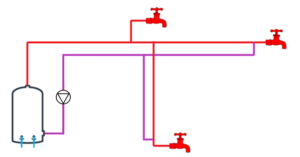Hot water recirculation system efficiency.
With more homes looking to save energy, many are moving to heat pumps which could see a massive reduction in instantaneous hot water systems (combi boilers)—bringing back the cylinder to your client’s homes. But looking further into a cylinder-based hot water system might have some hidden benefits that your clients might not have considered.
“Heating” hot water
Did you know every time a gas combination boiler has to heat water, the efficiency of the boiler drastically drops whilst generating hot water. This is because you have to push your flame rate in the boiler up, causing it to fall out of the condensing mode. You are dropping the efficiency to as low as 70-80%. A system-style hot water system relies on storing water, removing these peak demands. Match this then to a heat pump, and you can operate four or even five times the input energy.
Reducing water use
This comes down to this article’s point, which is a recirculation loop. By looping the hot water back into the cylinder and pumping this, you can massively decrease water usage, whereas a combi boiler (that cannot really have a secondary loop) has to heat up water, pipes, and heat exchanger, and then send it through the pipes around the house. Then, finally, you get your hot water. This is frustrating to wait that long and can waste as much as 12 litres of water every minute of running. By recirculating, you eliminate this issue by having hot water when you need it (which is also a massive time-saving).
However, a few things to consider to minimise energy loss.
Insulate your system
The larger the system (including the pipes), the more energy you lose to use up the reheat. You can be losing as much as 30w/m on a simple 15mm bit of pipe. Compare this to 7w/m if this was insulated. So make sure both your cylinder and pipework system (both hot water flow and return is insulated as much as possible). Remember, we do pre-insulated pipe to save time!
Install a timer
When you are asleep, the chances are you are not using hot water, so why not install a timer on the secondary pump for your customer? Therefore at night, you are saving the energy you would have lost through the pipe system (even if it is lagged). Why not go even more fancy and hook it in with a PIR sensor, so any time someone is in a WC, the pump turns on…
Type of owner
If you have a larger family that uses hot water daily, a cylinder is for you. However, if you are out most of the day and live on your own, an instantaneous water heater is better for you. So consider the occupier of the house. This is because storing anything (no matter how good the insulation is) does always lose energy. The longer the period the system is not used, the more energy is lost.
As always, if you have any questions, our friendly team is here to help! Give us a call on 01245 227630 or email [email protected].



